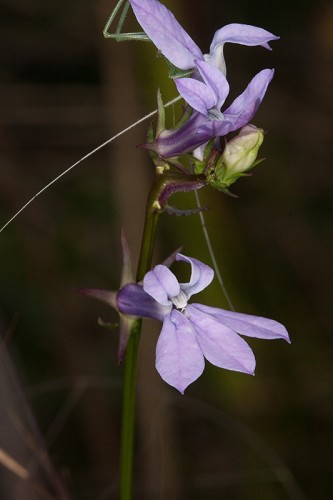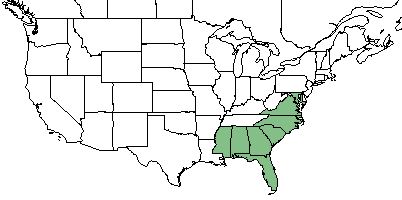Difference between revisions of "Lobelia glandulosa"
(→Ecology) |
(→Ecology) |
||
| Line 39: | Line 39: | ||
<!--===Fire ecology===--> <!--Fire tolerance, fire dependence, adaptive fire responses--> | <!--===Fire ecology===--> <!--Fire tolerance, fire dependence, adaptive fire responses--> | ||
<!--===Pollination===--> | <!--===Pollination===--> | ||
| − | + | ===Use by animals=== | |
| + | The Twin-spot Skipper (Oligoria maculata) has been observed on this species. <ref name ="FFE">Observation by Edwin Bridges in Polk County Fl., comment by E. Michael Powell and Linda Cooper, November 16, 2016, posted to Florida Flora and Ecosystematics Facebook Group. </ref> | ||
| + | <!--Herbivory, granivory, insect hosting, etc.--> | ||
<!--==Diseases and parasites==--> | <!--==Diseases and parasites==--> | ||
Revision as of 15:26, 2 July 2018
Common name: glade lobelia [1]
| Lobelia glandulosa | |
|---|---|

| |
| Photo by the Southeastern Flora Database | |
| Scientific classification | |
| Kingdom: | Plantae |
| Division: | Magnoliophyta - Flowering plants |
| Class: | Magnoliopsida - Dicots |
| Order: | Campanulales |
| Family: | Campanulaceae |
| Genus: | Lobelia |
| Species: | L. glandulosa |
| Binomial name | |
| Lobelia glandulosa Walter | |

| |
| Natural range of Lobelia glandulosa from USDA NRCS Plants Database. | |
Contents
Taxonomic Notes
Synonyms: none
Varieties: none
Description
L. glandulosa is a perennial forb/herb of the Campanulaceae family native to North America. [1]
Distribution
L. glandulosa is found along the southeastern coast of the United States from Mississippi to Maryland. [1]
Ecology
Habitat
L. glandulosa is found in seepage slopes, pitcher-plant bogs, streamhead margins, pine savannas, flatwoods, and margins of beaver ponds. [2] Specimens have been collected from cypress palm palmettos in sandy peat of cypress dome, low swamp, wiregrass bog, mixed hardwood, wiregrass savanna, pine flatwoods, and edge of limesink pond. [3]
Phenology
L. glandulosa flowers all months of the year except June and August. [4]
Use by animals
The Twin-spot Skipper (Oligoria maculata) has been observed on this species. [5]
Conservation and Management
L. glandulosa is listed as endangered/extirpated by the Maryland Department of Natural Resources Natural Heritage Program. [1]
Cultivation and restoration
Photo Gallery
References and notes
- ↑ 1.0 1.1 1.2 1.3 USDA Plant Database https://plants.usda.gov/core/profile?symbol=LOGL
- ↑ Weakley, A. S. (2015). Flora of the Southern and Mid-Atlantic States. Chapel Hill, NC, University of North Carolina Herbarium.
- ↑ URL: http://herbarium.bio.fsu.edu. Last accessed: June 2018. Collectors: R. Kral, S.C. Hood, C. Jackson, R.K. Godfrey, Loran C. Anderson, Ann F. Johnson, Nancy Edmonson, Sidney McDaniel, K. Craddock Burks, Christopher Campbell, Robert Lazor, John B. Nelson, R. H. Wnek, John Morrill, Sara J. Noyes, P. Denelle, G. Fleming, O. Lakela, R. R> Smith, T. Myint, A. F. Clewell, Robert Blaisdell, George R. Cooley, R. J. eaton, J. D. Ray, R. W. Long, Wm. G. Atwater, R.A. Norris, R. Komarek, R.L. Wilbur, F. G> Tarbox, O.M. Freeman, Harry E. Ahles, S.L. Orzell, E.L. Bridges, P. Sheridan, Frankie Snow. States and counties: Florida (Martin, Okaloosa, Liberty, Bay, jackson, Bay, Santa Rosa, Franklin, Leon, Gadsden, Liberty, Sarasota, Nassau, Calhoun, Wakulla, Taylor, Levy, Lafayette, Madison, Hernando, Volusia, Okaloosa, Okeechobee, Citrus, Putnam, Charlotte, Collier, Union, Martin, Hillsborough, Dade, Pasco, Dixie, St. John) South Carolina (Jasper, Horry, Berkeley) Alabama (houston, Russell) Georgia (Thomas, Emanuel, Clinch, Atkinson, Grady)
- ↑ PanFlora Author: Gil Nelson URL: http://www.gilnelson.com/PanFlora/ Date Accessed: 5/24/18
- ↑ Observation by Edwin Bridges in Polk County Fl., comment by E. Michael Powell and Linda Cooper, November 16, 2016, posted to Florida Flora and Ecosystematics Facebook Group.